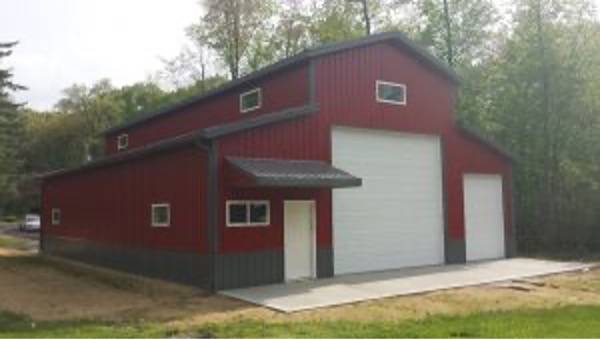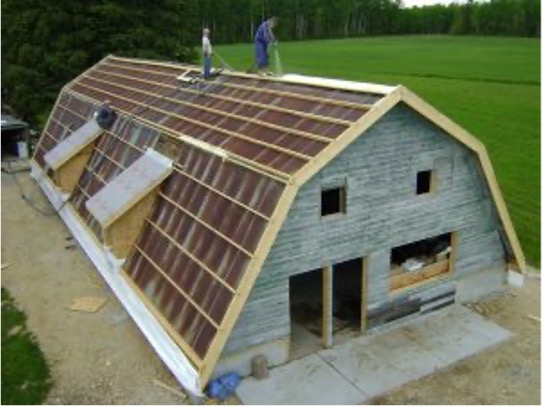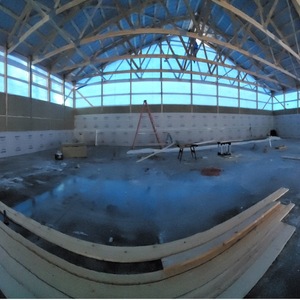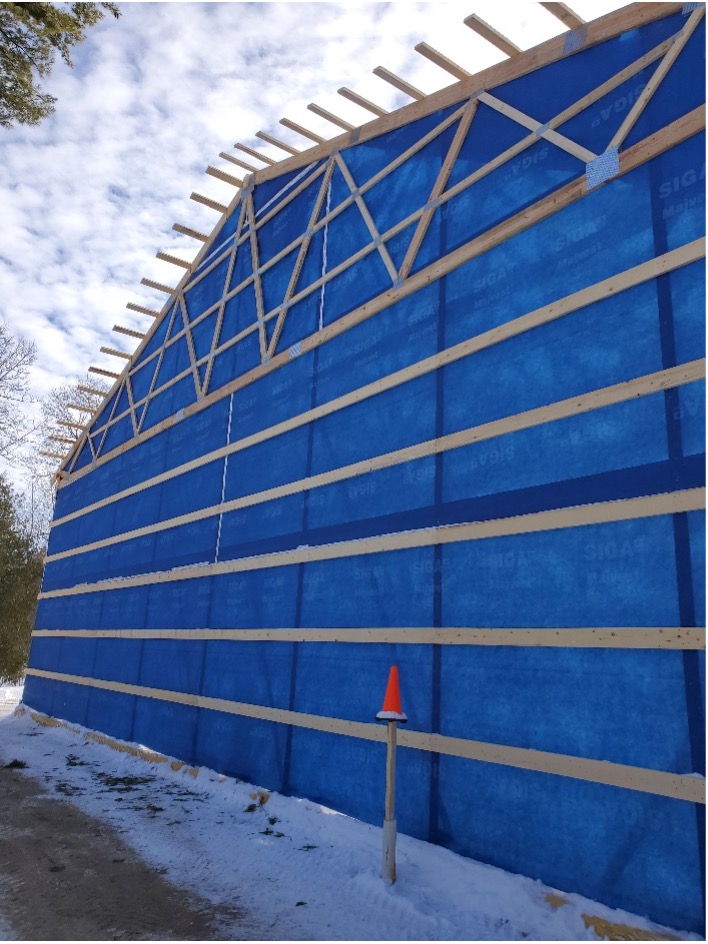
In my area of Grand Rapids, Minnesota, a new kind of construction method for building home / storage structures is gaining traction. The technique uses the shell of a typically less expensive barn or post-and-frame structure to build a single-family house. (Don’t confuse post and frame with timber frame.) This “house” often includes a large garage or shop space. Actually, it might be more accurate to say the garage or shop area includes living quarters. The adopted term for this type of structure is “barndominium.”
I’ve worked on several of these types of structures, many of which were simply large storage spaces converted into homes. One project kept the original skin of the barn and added an entire cabin inside of it. The cabin overlooks a small lake; the original sliding doors on the lake side of the barn can be closed when the place is not occupied, completely hiding the cabin inside.

The photo to the left shows a barndominium I worked on in 2009. The original barn was built, I believe, in the 1930s. (Not surprisingly, the structure is very crooked and out of square, which is both part of the character and the challenge of working on such a building.) The owner had the top roof section removed and placed on a slab. We were hired to complete the shell. We used closed-cell spray foam outboard of the original roof. The idea was to leave the inside ceiling untouched, exposing the up to 24-in.-wide old-growth pine roof boards.
I can attest to the growing popularity of post-and-frame structures being built for or converted into living spaces but I have noticed, too, how unpopular they are with the high-performance building community. But the reality is there’s a market for this type of construction, so how can we…
Weekly Newsletter
Get building science and energy efficiency advice, plus special offers, in your inbox.

This article is only available to GBA Prime Members
Sign up for a free trial and get instant access to this article as well as GBA’s complete library of premium articles and construction details.
Start Free TrialAlready a member? Log in















30 Comments
Randy,
If you haven't already check out RR Buildings YouTube channel (https://www.youtube.com/c/RRBuildings). Kyle does a lot of post frame buildings most of which have living quarters so he faces a lot of the same energy efficiency related challenges that you are addressing.
Thank Dave, I had the opportunity to chat a little with Kyle at IBS. He does a great job on his buildings, and I think his channel is part of the reason of the popularity of barndominiums.
Thanks for this article! Am planning a 40x40 post frame house in 55312. Choosing post frame because of the metal exterior, large interior spans and ease of building exterior shell.
Am very interested to see what you are planning for air sealing with your target of 1 ACH50. Also, would like to see your approach to detailing window and door openings.
What type of ground loop are you planning for the GSHP? Was originally planning GSHP but am considering cold climate ASHP due to the simplicity.
Hi Erik,
The GSHP will have 11 vertical loops, drilled wells. Mostly water to water but there is one forced air unit for summer AC and to supply heat to the second story of the living quarters.
It is not so much that the pole barn house is “Unpopular with the high-performance building community.” All too often it seems people have built the barn part of their barndominium and only then do ask “how do I make it be a high performance green building”. To my mind the pole barn is a more expensive way to get to the same place.
I look forward to seeing how you will pull this rabbit out of your hat on a lower budget.
Seems likely no one has done a cost benefit analysis of this or any high performance barndominium. I find it hard to believe that if you design an R60 roof R30 walls and less than 1ACH50 pole barn a conventional building with the same specifications will not cost less to build.
I think the same cost benefit analysis of the ground source heat pump would prove it is a total waste of money.
My guess is if anyone calculated the temp of the Hydronic concrete slab with R60 roof R30 walls and less than 1ACH50 the temp number will be about 85° not the toasty warm number the people paying the bills have imagined.
Walta
Randy works in a rather extreme climate. Note 5 feet frost depth. That changes metrics considerably both in terms of concrete and other material savings with post frame as well as the necessary higher hydronic run temps even with excellent insulation and airtightness. I too look forward to seeing the solutions on this project but I think I'm more optimistic on the cost-effectiveness having seen what "conventional" insulation upgrades look like in zone 7.
Why not see how it was done by these guys, who used post frame construction to do a very good house on a budget of under $150 sq ft.:
475 Building Supply: "475 On-Site: Net-Zero Upstate NY, Passive-esque House On A Budget" https://www.youtube.com/watch?v=PKXNwdvUNj4.
Nick,
Some very interesting well thought out details there.
To me it also does sort of confirm my contention that starting with certain building techniques as the main drivers can lead to pretty uninspiring architecture.
“[Deleted]”
Thanks Randy, another good blog.
As a building type I think bardomimiums have the potential to be very interesting as both urban and rural work/live structures, which offer a lot of flexibility.
My main caution would be the same as it is with any building where the primary driver is a certain structural system, or energy high performance. It's easy to get deeply involved in solving the practical details and make the architecture subservient to their demands. A house isn't primarily about the efficiency of its framing or shell. It's somewhere to live - the stage for most of the significant events in our lives. if you don't get the architecture right, it won't work for the inhabitants.
Right now most of the pole buildings and barnominiums I see are falling Into that trap. Frankly almost all of them look like hell, interact p0orly with the site around them, and have unworkable floor plans. Those are the things I'd address before getting to the details.
That said, I'm looking forward to seeing how Randy solves what are definitely problematic aspects of pole building.
You are right, I don't like the look of many of them. I suspect many who build them are more interested in the ability to fit all of their gas guzzling toys than appearances.
Technically the post frame style allows for many variations and if you look at "high end barn homes" in architectural digests and Pinterest, you will see quite a few interesting designs, especially overseas. Those who like big open spaces will be right at home
Nick,
With the right starting point I don't see why they couldn't be made to work in a lot of climates. Here in seismic land they are a non-starter for houses, but are fine for accessory buildings on flat lots, where those requirements don't apply.
Yes, seismic issues complicate so much. I am lucky: New Jersey has a lot of "stuff" to deal with but (so far) earthquakes are not among them!
Thanks Malcolm,
I agree, I've been to many Barndominiums that I had no idea had living quarters inside. They look like a big storage building. I think that's the look some people go for. The design on this is the best looking one I've seen. The basic plans were in place and many of the decisions were made before I became involved. I have been given the reins on the control layers and made several changes to them from what was originally planned. There will be several more posts on this project on the coming months.
As I said in previous posts, this is a great idea. There are many advantages to using post frame: lower costs (mainly due to no foundation and very efficient building packages and contractors who put up the shell very cheaply) and much less concrete/imbedded carbon.
Here are some folks who have done just that: a post frame house for $147 sq ft close to passive house performance: less than 1 ACH50. This is courtesy of 475 Building Supply: "475 On-Site: Net-Zero Upstate NY, Passive-esque House On A Budget" https://www.youtube.com/watch?v=PKXNwdvUNj4.
What I love about this build is it has no exterior sheathing or spray foam....instead they use 2x4 girts, Intello and Mento and rockwool. I would have preferred they also get rid of the concrete slab and use a raised wood floor instead, but that is maybe the next project????.
How necessary is the Mento vs something like commercial tyvek?
Thanks for sharing the video Nick. I'm in the planning stages of a "pretty good house" pole frame design and it's reassuring to see that this is being done.
In terms of bypassing the concrete slab I'm thinking of a design similar to what the guys on the Unbuild it Podcast talk about in Episode 42 or 43 and it's actually close to something my dad did 30 years ago when he build our timber frame house.
He laid down 2 inches of polyiso on top of his vapor barrier which was on packed gravel with a finished layer of gravel screenings. He simply laid down pressure treated 2x4s 16 inches on center and nailed his 5 quarter yellow pine floors to that. So far nothing has settled.
Article on GBA about a similar concrete-less slab:
https://www.greenbuildingadvisor.com/article/another-take-on-a-concrete-free-slab
Am also planning an energy efficient post frame house. Like the idea of the concrete-less floor. The articles and tips from this site have really next-leveled my planning process.
Thanks, some great details in that article. I'm going to post a description and hopefully some design images of my plans on the Q&A page to ask for a critique of the details it will no doubt have Post Frame in the title.
Hope to see some of your plans on GBA.
Here's what my plans looked like before reading GBA:
https://www.youtube.com/watch?v=IQvE9pc9tbE
Will make another video with the design changes inspired by GBA. Latest design is simpler and heating load has dropped from 3 ton to 1.5 ton (GSHP > ASHP), thanks to a slew of changes inspired by this site.
Hi Erik,
That concreteless slab on grade house you mentioned is also a project I was involved in, funny thing is that and the Barndominium project are about a mile from each other. I was recently contacted by someone in Northeastern Minnesota that also wants to combine post and frame with the concreteless slab. Hoping to meet with him in the spring.
Good Luck!
How did you deal with pests?
Thanks,
We had carpenter ants and mice but so did every other house in the area. I forgot to say that this was laid inside a concrete block foundation wall.
Montypbbc,
The big difference between the traditional use of foam, and more current practices in high performance houses, is that it is now often load-bearing, or fundamental to the house's functioning - meaning effective measures against pest infiltration are now much more important.
“[Deleted]”
Erik,
Tyvek Commercial is fairy vapour open (28 perms), and is really robust. I understand the thinking behind perhaps paying more for a variable perm interior vapour retarders, but don't see much advantage to Mento as a WRB.
I found it interesting that in the project I mentioned above, which is built in zone 6, the venting for the roof is through the Mento, which is wrapped tightly around the roof/wall intersection and then the venting space is created by 2x4's laid above the Mento. The designer claims that this is all the venting they need. I also note that they spent a lot of time on making sure there is little or no air leakage into the roof assembly from below.
Nick,
I think Mike Maines has used similar roof venting design. Like the rest of the structure, things that work on a simple one storey, rectangular, gabled roof house might become pretty difficult to execute on a more complex design. I'd be reluctant to take on fastening the vertical strapping over the underlayment on a higher, steeper pitched roof.
After all the careful thinking involved in avoiding sheathing on the walls and roof, I'm surprised they opted to use OSB on the ceiling, rather than another sheet membrane.
Yes, that was an interesting choice with the OSB. It seems the intello/drywall would suffice.......
I agree that complex roof designs change the equation in many ways. I think most post and beam structures use relatively low pitched roof designs with few roof complexities. Personally I seem to favor very simple designs (perhaps because my family roots on my mother's side go back to St John's Newfoundland-simple hardy people).
I occasionally see these types of residences and they resemble little more than a workshop with modular living space akin to an office. I really question how well the living space is sealed off from the workshop. Especially at the ceiling. It's almost akin to living in ones garage along with all the noxious substances typically found in a garage.
Log in or become a member to post a comment.
Sign up Log in